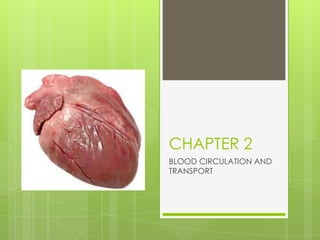
Chapter 2 Blood Circulation & Transport
- 1. CHAPTER 2 BLOOD CIRCULATION AND TRANSPORT
- 2. 2.1 The Transport System in Human Being Internal transport system is needed to deliver useful materials to body cells and remove waste materials Internal transport system Circulatory system Human circulatory system Double circulatory system Blood must flow through heart twice Pulmonary circulation Transport blood between heart and lungs Systematic circulation Transport blood between the heart and all other parts of body
- 4. Characteristics of circulatory system • Circulating fluid Blood Transports useful and waste materials Pumping device Heart Move through body by muscular contractions of heart Blood vessels 3 main types of blood vessels: arteries, veins and capillaries Valves Present in some blood vessels Prevent backflow Ensure blood flows in 1 direction only
- 5. Structure of human heart To head From head and body and body To lungs From lungs Bicuspid valve / mitral valve Septum From trunk and legs
- 6. Blood Vessels and Their Functions 3 types of blood vessels: Arteries Veins Capillaries Human circulatory system is called a closed system
- 9. Comparisons Characteristics Artery Vein Capillary Cross section Size of lumen Small Big Small Thickness of Thick, muscular thinner, Wall only one wall and elastic muscular and cell thick walls less elastic Valves Absent Present Absent Blood flow Fast and under Slow and under Slow and under very high low pressure high pressure pressure
- 10. Characteristics Artery Vein Capillary Colour of blood Bright red, Dark red, Bright red, inside contains contains contains oxygenated deoxygenated oxygenated blood (except blood blood pulmonary artery) Function Carries blood Carries blood • Connects away from to heart arteries and heart veins • Allows exchange of substances between blood and body cells
- 11. Path of Blood Flow Aorta Pulmonary artery Pulmonary vein Vena cava
- 13. Maintaining a healthy heart Factors that increase risk of getting heart disease: Heredity Cholesterol and obesity Lack of exercise Smoking Stress Alcohol
- 14. Human Blood Blood Plasma Blood Cells Blood Fragments Red Blood White Blood Platelets Cells Cells Plasma makes up 55% of blood by volume The other 45% consists of red blood cells, white blood cells and platelets
- 15. Plasma Yellow liquid in blood 90% of plasma is water 10% of plasma include: Nutrients: glucose, amino acids and vitamins Proteins: antibodies, hormones, enzymes, albumins and fibrinogen Inorganic ions: sodium, calcium, chlorides and phosphates
- 16. Main functions of plasma: To transport nutrients to tissues To remove waste products from tissues To distribute hormones, enzymes, antibodies and other proteins To distribute heat energy from liver and muscles to all other parts of body
- 17. Red Blood Cells (erythrocytes) Biconcave, disc shaped cells without nucleus
- 18. Transport oxygen from the lungs to all parts of body Contain a red pigment called haemoglobin which combines with oxygen molecules to form oxyhaemoglobin Carry carbon dioxide from body cells to lungs RBC are produced in bone marrow Lifespan: 120 days When RBC are worn out, they are destroyed in liver and spleen
- 19. White Blood Cells (leucocytes) WBC are much larger than RBC and they each have a nucleus Usually irregular in shape, colourless and do not contain haemoglobin
- 20. Produced from bone marrow cells Lifespan of WBC depends on type of WBC. It varies from a few hours to a few months Play a vital role in body’s defense against diseases Produce antibodies WBC can squeeze through walls of blood capillaries into the space among the cells to destroy the bacteria
- 21. Platelets (thrombocytes) Play an important role in blood clotting
- 22. Blood groups ABO system classifies the human blood into 4 groups called A, B, AB and O. During blood transfusion, donor’s blood must be compatible with the recipient’s blood When an incompatible type of blood is transfused, RBC of donated blood will agglutinate and cause fatal blockages in recipient’s blood vessels
- 23. Donor’s blood O A B AB O Recipient’s blood A B AB Compatible Incompatible
- 24. Blood group O can safely donate blood, in small quantities, to anyone. People with group O are called universal donors Blood group AB can safely receive blood from anyone. Group AB people are called universal recipients
- 25. Transport system in Plants Wilting Non woody plants depend on the water stored in the cells of the stem for support Wilting occurs in non woody plants when water loss through aerial parts of plant exceeds water absorption by roots Cells in plants lose their turgidity (stiffness) and the plant droops
- 26. Transport Tissues in Plants Transport system in plants is made up of Xylem tissues Phloem tissues They are found in roots, stems and leaves
- 27. Cross section of root Cross section of stem
- 28. Cross section of leaf Upper epidermis Lower epidermis
- 29. Xylem tissues Made up of xylem vessels Form woody tissues of plants and give support Transport water and dissolved minerals from roots, up the stems and to the leaves
- 30. Phloem tissues Transportfood substances from leaves to the stems and roots Xylem and phloem tissues form vascular bundles
